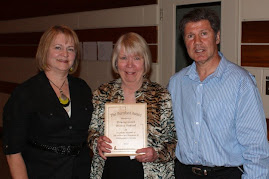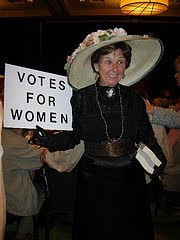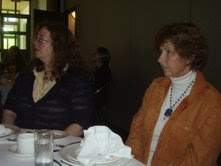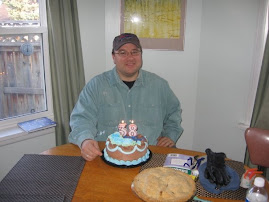Tuesday, May 5, 2015
The Yegg Boy, a Historical Mystery, by Joan M. Baril
This short story was first published by The Antogonish Review in 2013 after winning third place in their annual contest. The Anitgonish Review nominated it for the 2014 Journey Prize. It was also published later by The New Orphic Review.
The
Yegg Boy
By
Joan M. Baril
“The Yegg Boy is in the paper,” her
husband says at the door of the greenhouse.
“What?”
Helen has not heard the name for thirty years.
He
steps just inside the doorframe holding the newspaper to shelter it from the sharp
May wind. “It seems they’re digging up the old graves at First Presbyterian to
make room for the expansion, and,” he reads, “and among the early residents
whose remains are to be removed tomorrow, only one achieved fame or rather
notoriety—eight- year-old Thomas Randall Teasdale, known as the Yegg Boy, whose
death at Victoria School in 1908 is still a mystery.”
Helen
waits a moment and then says, “So, his middle name was Randall. I didn’t know that.”
Helen first learns about the Yegg
Boy in August, 1982, the day she arrives at the small town of Port Gill to
check a hundred-year-old elementary school building and report on its
suitability for heritage status. She’s divorced, in her mid forties, and a
researcher with Ontario Heritage. She sings as she drives, glad to be out of
the Toronto heat, out of the archives, and out in the field, a simple task
ahead, one she knows she’ll enjoy. A piece of cake day.
The morning mist
from Lake Ontario simmers across Highway 401 as she takes the exit, dropping down
towards the lake, moving past a couple of gas stations and fast food joints to
enter, unexpectedly, a street of mature trees, great oaks and maples, whose branches
half-hide an exuberance of Victorianna: brick, stone and half-timbered houses,
many flaunting towers or turrets, wrap around porches or glassed-in verandas.
What good luck
to come across such an old-fashioned parade she thinks as she checks the street
sign on the corner. Empire Street. Could any name be more fitting? She’ll walk back
later and take notes. She knows, of course, that Port Gill holds many more modest
streets, but she loves the wealthy imprint of a vanished age so often found in
small Southern Ontario towns, especially those that front on Lake Ontario or
Lake Erie.
How different from
the northern town where she grew up with its haphazard shapelessness. As usual,
the thought of Nipigon triggers an inward wince, the remnant of a time where
every face knew her story and where, it seemed, she could not turn a corner
without running into her ex-husband, usually with her on his arm. She flings aside the flick of humiliation and
resolutely turns the Honda into Port Gill’s main drag: a boxy line of shops, a
few shuttered and closed, and two stately bank buildings, also worth a look
later.
Ahead, the old school
almost has her slamming on the brakes. She pulls over to take it in. The
building stretches across the top of the street, golden pink and solid, two
stories of Port Credit sandstone, set in a half circle of green lawn. On the
second floor, above the double oak doors, she sees the famous round window, the
jewel which will save the building from the wrecking ball. The window is the focus
of the street. At least ten feet in diameter, made of radiating coloured glass
panels, it resembles a multicolored daisy, its circular centre containing a painted
glass portrait, the head and shoulders of old Queen Victoria herself,
presenting her pudgy profile to the street below.
The building
breathes the 1880s, and Sir Wilfrid Laurier and the twentieth century belonging
to Canada. Helen does not have to see the opening day photograph to envision the
top hats, the substantial stomachs, the gold watch chains, and the respectful
crowd in the background, and later, when she sees the actual picture, she’s not
far wrong.
“Would you like
to see the place where they found the murdered child?” the school principal,
Mark Ryko, asks.
The outlandish
question snaps her back. They’re standing in the wide front hall of the school looking
at portraits of former principals and she’s been musing how pleasantly inefficient
the old architects were with entrance space. The hall and two sweeping
staircases take up almost the entire ground floor. The downstairs contains only
three classrooms, all lined up across the back.
Mark Ryko at
smiles at her. “No, no. Don’t be upset. It was a long time ago. 1908 to be
exact. Let me show you.”
She’s spent the
morning with Ryko and so far, she likes him. She admires his easy rapport with
the teachers they met as they toured the classrooms. He’s a stocky man, with a
wide smile and a purposeful walk, shorter than she and perhaps a year or two
younger. Now, she follows him under one of the staircases (marked girls’ stairs
on the original plans), through a small door, down a flight of oak steps scooped
out by the passing of countless little feet and into a low ceilinged basement
room.
Mark explains. “For
many years, this basement was divided into two sections, a girls’ basement and
a boys’. This was the girls’ side. Far as I know, no amenities. The kids just
ran around, I guess. And during the baby boom years, they actually set up classrooms
down here. Then for a while it was a playroom; but of course, now we have the
gymnasium in the new wing.”
Helen shudders inwardly
at the mention of the new wing, an aluminum extrusion mercifully hidden at the
back of the building. But, she thinks, even a 1960’s utility box is preferable to
this dungeon space with its deep-set, barred windows.
The principal points
to a roughened patch on the concrete floor. “Here’s where they found the body,
face down in a pool of cement. Found on a Monday morning in April, 1908. On the
Friday before, a crew of workmen dug the pit and filled it in with cement. Then
on Monday, when they arrived, they found the child. At first they thought he’d
fallen down the stairs, landed in the wet slurry and drowned. But here’s the
mystery. He hadn’t drowned. He’d been hanged or maybe strangled, no one knows
for sure.”
“Strangled. Hanged?
Oh the poor child!” Helen feels a shiver of horror as she stares at the rough
patch easily visible on the scuffed floor. “How does a school pupil get hanged?”
“There was an inquest, of course,” Mark says. “The
clippings are upstairs, if you’re interested.”
“A boy. How
old?”
“Eight,” Mark says, “And supposedly small for
his age. Very little known about him except his name was Thomas Teasdale.”
“Thomas Teasdale,”
she says slowly. “Such a melodious name. His parents must have been devastated.”
“Ah, well, he wasn’t
called Thomas you see. Everyone—except the teachers, I hope—called him the Yegg
Boy.”
She’d come
across the word before. An old Canadian word. A yegg was a sort of tramp—or
thief. A general no-good. “Whoa,” she says incredulous. “They called an eight-year-old
boy, a yegg?”
“Rough times,
then. The child had no parents. He was more or less a homeless kid. Apparently
he sometimes stayed with an uncle, a bad character, but that guy was in the Don
Jail the day the kid was murdered. No one was ever charged. I often wonder how
hard the cops worked to find the killer of a kid from Tarpaper Town.”
“Tarpaper Town?”
she says. “That’s not on the old maps.
“Oh, they never
are,” Mark says as he leads the way up to the second floor and toward the front
of the building. He holds open the door of the teachers’ room and the coloured
window leaps into view, sending red, yellow and green lights wheeling around
the walls. Up close, Queen Victoria looks even more disgruntled than she did
from the street. Quickly, Mark pulls the cords that allow long drapes to settle
across the window muting the flying colours. “Drives you crazy, sometimes,” he
says, “as if you’ve fallen into a pit of fireworks or an explosion in a paint
factory. No one knows who designed it. But the town loves it of course.” He
rummages in a filing cabinet and brings out a folder of Xeroxed newspaper clippings.
“Coffee?” he
asks.
Helen nods and, while
he fills the pot at the counter, she takes her high-powered magnifying glass from
her purse and applies it to the cramped 1908 newspaper lettering, her pity for
the child deepening as she reads.
According to the
coroner, a Dr. Sewell, “the Teasdale boy died of strangulation at least two
days before the body was discovered. Two marks circled the child’s neck, a
higher line close to the ears, consistent with a hanging and another circular
mark lower down where the kerchief around his neck had been tightened. Once again Helen feels a shudder. “Massive damage
to the windpipe,” the doctor testified, “but I cannot say with certainty which injury
was the chief cause of death.”
“So someone
hanged him and then changed their mind and strangled him?” Helen says to Mark
trying for a light tone to counteract the horror she feels.
“Seems insane,
doesn’t it?” He puts two mugs of coffee on the table adding a bowl of sugar and
a small carton of cream from the miniature fridge.
Helen reads on. The
principal at the time, a Mr. Greenwood, also testified. According to him,
little Thomas had made a rare appearance at school. Besides being a poor
attender, he was a poor student as well. “It seems,” she says to Mark, “that the
child had the bad taste to faint during morning assembly and fall part way down
the main staircase.” She says this making a query face.
“They stood on
the stairs, Helen, for the assembly—the boys on the boys’ stairs and the girls
on their side.”
“They stood?”
“Well, they didn’t
have folding chairs in those days, I imagine. Yes, they stood every Friday
morning as long as an hour or even more. Mostly hymns, prayers, patriotic songs
and so on. Some of the old programs are in the board archives.”
Helen went back
to the clippings. Little Thomas was taken to the lady teachers’ room and was
allowed to lie down for half an hour. Then, as punishment, (for fainting?) the principal
decreed the child be kept in at recess. However, at the end of the morning, he
seemed so sickly, his teacher, a Miss Evelyn Carstairs, sent him home. “How do
you send a homeless child home?” Helen asks.
Mark shakes his
head, raises his coffee mug.
The jury came to
the school to examine the cement pit where the body was found. The school was installing sewers for
the first time and a set of toilets in each basement area. The pit was the
place where the inside and outside pipes connected. The area was about five
feet square and, on this Friday, the workmen had mixed the cement, filled in
the hole, smoothed it over, taken their tools and left, leaving their foreman,
Salvatore Maltese, to lock both the inside and outside basement doors and take
the keys to the principal. The keys were kept on a hook in the principal’s
office.
The principal,
who seemed to be the major testifier at the inquest, said: “I went into the
basement a few minutes after the crew left. I checked the concrete work,” (no
small body lying there presumably), “checked the new sanitary facilities and
then returned to my office on the second floor after I relocked the basement. Forty
minutes later, the vice principal and I left the building. We were the last ones
to leave. As was our custom, we walked around the building to make sure all the
outer doors were completely secure.”
The last to
testify was Thomas’ teacher, Miss Evelyn Carstairs. She simply corroborated
what the principal said and added, “the child seemed so pale and faint by lunch
time that I sent him home.”
Did he have
breakfast that day, Helen wonders. Did no one think to feed the poor creature? Apparently
not. She stares at the only illustration on the page, a line drawing depicting Miss
Carstairs’ very young and pretty face under a sweep of hat and upswept hair. Obviously,
she alone caught the artist’s eye. No picture of Thomas Teasdale, unfortunately.
Helen puts down
her coffee cup and unrolls her blueprints and building plans. The original
building had no bathrooms, not even in the two teachers’ rooms—the men’s in
which they are now sitting and the lady teachers’ room, a windowless box, also
on the second floor.
She finds the 1908
blueprint for the “new” basement washrooms, two toilets in each section of the basement,
unpartitioned from each other and beside them a separate cubicle marked “teacher.”
It must have seemed to everyone, teachers and pupils alike, that progress was
evolving as it should, especially when they recalled the long icy trip across
the playground to the outhouse in winter.
“It really is
very simple,” Helen said picking up the cup which Mark had refilled. “The teacher
dismissed the boy. Instead of going home, he hid himself somewhere inside the
school and then, when everyone was gone, and the school was empty...”
“Murdered
himself and threw himself into the pit,” Mark interrupts with a rueful smile. “Somehow
getting through a locked door on the way.”
“OK,” Helen smiles.
“It must have been the principal. He alone had the key.”
“And the motive?”
Mark says. “Fainting during Friday assembly? Rough discipline even for those
days.” He puts down his coffee cup. “Actually, the foreman, Maltese, was the
suspect of course, a foreigner and all. And on top of that, he left town after
the murder and was never seen again. Probably a wise move.” He stands up. “There
are another couple of articles in the last folder if you want to read on.” He
rinses his cup at the little sink and sets it on the drain. “Unfortunately, I
have to get back to work here. Three hundred little screamers arriving next
week. I want to be ready. If possible.”
“Will any of
them be poor and homeless?”
“Ah indeed.” His
sigh turns into a sort of hopeless groan, but he says, “No doubt, no doubt.” As
he moves toward the door, he says, “I’ll be in my office if you need anything.”
Helen stares
into space, her imagination netted by the story of the Yegg Boy. The school
settles into a half silence. She hears the janitor’s floor polisher from the
first floor and the scrape of a file drawer from Mark’s office next door. It’s
eleven o’clock. Even with the curtains closed, colours vibrate across the walls
and across the papers spread on the table.
She regards
Queen Victoria, barely seen through the drapes, portly and relaxed, in the hub
of her coloured wheel. Did little Thomas Teasdale ever stand in front of this beautiful
window? Probably not, although he may have stood in the principal’s office next
door and been bawled out for fainting, or missing school or for generally
having committed the sin of being poor and malnourished and ill.
Helen leans over
the two remaining clippings on the table. A little more information about
Thomas. He had no address but sometimes slept in the back shed of a “confectionery”
in Tarpaper Town. The last clipping was an editorial from the Port Gill News
Leader. It suggested rounding up all homeless boys and putting them in an
orphanage where they’d get a good Christian training. It also suggested burning
down Tarpaper Town. “Do we need slums,” the editor said, “which encourage all
sorts of disgusting habits and harbour degraded foreigners? Tarpaper Town should
be wiped off the face of the earth.” No wonder Maltese had skipped.
Mark is not in
his office when she looks in; perhaps he already went for lunch, so after a quick
hamburger from a restaurant on the main street, she retrieves her collection of
picks and scrapers from the Honda intending to take a preliminary look at the
original paint colours. She starts in the primary room on the first floor, a
big classroom with high windows, a long separate cloak room and a walk-in supply
closet. Pushing aside a tall bookcase at the back, she slices away a sliver of
paint expecting to come across layer upon layer of colour; but instead, a few
slices down, she arrives at a black stain, obviously charcoal, the evidence of
a fire.
At that moment, Violet
Smith, the primary teacher, who Helen met earlier that morning, walks in
carrying an arm load of books. She reminds Helen of Queen Victoria in the
window, the same soft face and severe grey hair but, quite possibly unlike
Queen Victoria, Miss Violet Smith’s voice reveals the careful enunciation of
the long-time primary teacher.
“Oh, Miss Smith,”
she calls out. “Did you ever have a fire here?”
Violet Smith immediately
halts, her pudgy face whitening as the stack of books in her arms cascade and
clatter across the floor. Her hands fly to her mouth and she moans as if in
pain.
Helen stares at
the teacher in astonishment. “I’m so sorry. I didn’t mean to upset you,” she
says.
Surprisingly
Violet Smith throws back her head and laughs loudly. “I suppose they’re not
going to dismiss me a year before my retirement. But, they do say, sins will
out, and so they do, indeed.”
“Sins?”
“It was a
pathetic sin, really,” Violet Smith says. “You see, there used to be a door at
the back of this classroom, close to where you’re standing. It led directly out
to the playground. And here,” she gestured, “just inside, the teachers on yard
duty sheltered on cold days. We had a small spirit lamp in the supply cupboard
safely hidden behind some books. We boiled water and made tea and watched the
children through the big windows.”
Helen is not
sure she understands. “And this was the sin?”
“Oh, glory! It
was so cold sometimes. And we were out half an hour at a time, from eight
thirty to nine in the morning and often the entire lunch hour. We were never allowed
a break in those days. Recess was just another work time. So, my dear, every
day, a secret tea party in this room.”
She gathers the
books from the floor before continuing. “When I started teaching, I inherited
the tea set.” She smiles proudly. “I was told the secret tea parties had been
going on ever since the school opened in 1883. Of course, you can understand I was
terribly nervous about being caught. We all were. Terrified. But I did love my
cup of tea.”
“Terrified?”
Helen says. It seems a strange word to use in the circumstances.
“Oh yes. But the
principal and the vice-principal were always upstairs in the men teachers’ room.”
Violet Smith chuckles softly as she places the books on a small desk. “We often
said what a mercy it was that the men teachers’ room overlooked the main street
and not the playground.”
“And you were never
discovered?”
“No never. But,
oh my, that fire was a close call. It was in 1935, my first year. A book or
some papers, I’ve never been sure exactly, just burst into flames and the fire
shot right up that wall with a flash!” Violet Smith covers her eyes with her
hands as if blocking out the sight. Her entire body gives a little tremor as
she continues. “A second later, Evelyn had it doused out with our water jug. The
room filled up with black smoke. Simply terrifying. Someone opened the outside door,
I don’t remember who. I was in hysterics. Terrible, terrible.” She shakes her
head as if to clear it. “Such a close call.”
Helen tries to
unravel the story. “I’m not sure I understand, Violet. Why were you so upset if
the fire was quickly put out and there was no damage to speak of?”
Violet Smith
looks at Helen as if she were a pupil who’d given a particularly foolish answer.
“That was a different time, Helen. The Great Depression. And no union then, my
dear! Quite simply, we all, all four of us, would have been fired. We did stop meeting
for tea for a while, but I’m afraid we drifted back. Anyway, it wasn’t long
after, some time during the war I think, the whole arrangement came to an end. Yard
duty was reduced and we were sent out only two at a time and the men had to
take their share as well. Halleluiah! We could go up to the lady teachers’ room.
We took the tea things up there and bought a little hot plate….”
Helen isn’t
listening but staring. One word lingers in her mind. “Evelyn? Did you say
Evelyn?”
“Yes, Evelyn
Carstairs. She had the room next door. She was always so calm and quick. The
next day, she brought some paint and at noon hour...”
Was it possible?
How could the Evelyn Carstairs of the yellowing 1908 newspaper drawing, the
upswept hat and high lace collar—how could that
Miss Carstairs have anything to do with the fire in 1935?
“It can’t be the
same one,” Helen blurts. “Thomas Teasdale’s teacher?”
Violet Smith’s
smile disappears. “Evelyn Carstairs taught here for forty-eight years. We
became very good friends. She helped me so much. It was very difficult in those
days, you have no idea.”
“What did she
say about Thomas?”
“Oh, my! A
dreadful experience for her. She said it was the most terrifying thing that ever
happened to her but having survived that, she felt she could survive anything.”
“Survived it?” Again,
a strange turn of phrase. “What did she mean?”
“Why, she was
sure she’d be fired, of course,” Violet Smith says. “In those days, you lost
your job over the slightest breach of the rules and her principal then was a tyrant,
she often told me that. Of course principals were expected to be tyrants. Things
are a good deal better...”
“But what rule
had she broken?”
“Sending a child
home without permission. Goodness, one didn’t do anything without permission. She
couldn’t sleep for weeks thinking that any minute she’d be called into the office.
She told me she used to shake with fright every time the principal looked at
her.”
Now it’s Helen’s
turn to shake her head. “It seems crazy to me. A child faints in the morning. Had
he eaten breakfast? Did anyone ask? He’s allowed to lie down for a while and
then punished by being kept back at recess and finally sent home. Sent home to
where? And after he’s found dead, his teacher can only think of her breach of
the rules?”
Violet Smith’s
jowly face reddens. “Well, Evelyn didn’t know this child. Classes were huge in
those days, forty or more sometimes, and that boy hardly ever attended. Besides
there was that other thing. He was one of those children who smelled. We hardly
get children like that nowadays but they were quite common once upon a time. Evelyn
made him spend the entire morning in the cloak room and she told me she
considered leaving him there for the rest of the day. I know that sounds
terrible but, my dear, those were different times, crueler times, I’m afraid. And
the child was from Tarpaper Town. I
remember everyone was so glad when they finally burned it down...”
“But what did
Miss Carstairs think happened to Thomas?”
“Oh, she
believed he wandered back into the building in the afternoon and hid himself away
and then, when everyone went home, he went down into the girl’s basement and
fell into that cement pit. He probably fainted again.”
“But he was
murdered.”
Violet Smith looks
momentarily startled. “Well, that’s what some say,” she says. “Even now people
still say that. Even now.” She turns and heads out the classroom door. “I have
to get more supplies,” she says and is gone.
Evelyn Carstairs was right. Her
1908 principal was a tyrant. Helen spends the next morning at the Board of Education
office running through all the old files. In the twelve years of Mr. Greenwood’s
reign, there were over a dozen requests to the trustees to fire a teacher, most
on the grounds of “improper conduct. Several were indeed fired as the minutes
showed, one young woman for attending the Roman Catholic Church with a friend
and another accused of becoming inebriated at a house party. In 1899, a young
male teacher was fired for leaving his classroom at lunch time while a student
was standing in the corner as punishment. A ruthless man, the principal. Yet
his personnel report was exemplary. The trustees approved of his methods. “He
is fair and firm with both staff and students,” was a typical comment found in
the minutes of 1908.
The 1907 minutes
spoke of hiring a lady teacher, Miss Evelyn Carstairs, sixteen years of age,
and a new male teacher as well—his salary to be $600.00 per annum and hers $325.00
and listed the staff for the coming year, four lady teachers for the primary
grades and three men, including Mr. Greenwood, for the seniors,.
Helen made a few
quick calculations. The sixteen year old Evelyn Carstairs was to teach for 48
more years and retire in 1956, close to half a century in the same school,
outliving by a long way tyrannical principals. If Violet Smith started teaching
in 1935, she spent twenty-one years in the classroom next to that of Evelyn
Carstairs. The solid linkage of present and past was astonishing and somehow
dizzying. Helen felt a kind of current, as if time itself, locked in the old
minute books, was sweeping backwards under her fingers.
The minutes of April,
1908: “The trustees discussed the recent death at Victoria School.” No more.
Helen reads on through the subsequent meetings of that year and nothing,
nothing, about the murder although everything else, including the new toilets,
was discussed in detail. She slams the minute book closed.
The Victorians
were so bloody euphemistic, so obsessed with façade. Something is left unsaid here,
she feels it, something connected to pitiful Thomas. How did Violet Smith
describe him? Disgusting. It’s the
same word the newspapers used to describe Tarpaper Town. Disgusting habits, the editorial said. Why disgusting, another
strange turn of phrase?
Helen grabs her
purse and drives the fifty miles to Toronto to the provincial archives, arriving
forty minutes before closing; but it doesn’t take more than twenty minutes to
find what she’s looking for. It’s all there in the court testimony. Thomas’ “uncle”
jailed for one year on the charge of procuring, procuring for child
prostitution. Poor, poor little boy, no wonder everyone found him “disgusting. Why
did he come to school at all? It was pitiful. How did his schoolmates treat him?
She can imagine. No doubt the parents warned their children to stay away from
him. No wonder they called him the Yegg Boy, but that was probably the mildest of
epithets.
And suddenly Helen
knows consciously, what she had known subconsciously from the beginning. She
knows who killed Thomas.
She thinks of
telling Mark the next morning as they walk to the former site of Tarpaper Town,
now a dusty waste of weed, sand and bushes, a little east of the main street,
between the lake and the train tracks, but for some reason, she can’t speak of
it. Of what use was her information? Useless dry stuff, like history itself, like
the blowing sand and grit around them and yet, and yet, the murder holds a
strange power, filling her mind with mental pictures and making it difficult to
concentrate on what Mark is saying.
“The
police burned Tarpaper Town down in October, 1939,” Mark says, “just after the
war started. Security reasons they said, it being so close to the tracks. There’ve
been many other shack towns in Canada and in the end they always get burned
down or bulldozed down or whatever: Tarpaper Town, Swamp Town, Hobo Jungle,
Shanty Town— they’re the other side, the shadow side.”
Helen remembers the
famous Rooster Town in Winnipeg, long destroyed. And after the Second World War,
she recalls with shame a poor section of Nipigon labeled D.P.Town.
“Violet Smith
says she’s glad they burned it down.”
“People are
always glad.” Mark is suddenly fierce. “Do you know how many people lived here,
Helen? Three hundred. That’s quite a large community when you think that Port
Gill had less than 10,000 people at the time.”
“Thomas Teasdale
lived here,” Helen says. “Did you know his uncle was a pimp, a child pimp. Probably
pimped out Thomas.”
Then Mark says
something that makes her really like him. “Oh God, the poor child,” he says. “Poor
tortured little soul.”
Helen feels the
Yegg Boy’s shadow walk beside her as she enters Violet Smith’s primary room at
the end of the day. The teacher is cutting coloured letters from construction paper.
“Evelyn Carstairs and you became friends?” Helen says.
“Firm, firm
friends. Right from my first day.”
“But, sooner or
later you must have realized that she murdered Thomas.”
“She certainly
did not!”
“She stowed him
in the cloak room for the day,” Helen says. “At morning recess she came here, to
this room, for the usual tea party. She left the child alone in spite of the
rule requiring her to stay in the class with him, isn’t that right? And when
she returned, he was hanging from one of those hooks in the cloak room. He had
the mark on his neck. So she...”
“He hung
himself,” Violet snaps, tears framing her eyes. “The child hung himself. The
other children called him such nasty names. Filthy words! And you are right, my
dear. I figured it out too. And eventually Evelyn did tell me. A suicide. Not
murder. No! The poor child was a complete outcast. People said he was a
prostitute. Not even the Tarpaper Town children were nice to him. We never could
decide why he came to school at all. She lifted him up off the hook but he was
dead. He was already dead. The bell was ringing. She panicked.”
“And so, she hid
the body?” Helen added.
“Of course she
did. You have to understand that she was very young, practically a child
herself. Sixteen years old. Her class was coming in. She hid the body in her
supply cupboard and then, after four o’clock, she went upstairs and she could
hear them all in the men teachers’ room, Mr. Greenwood and the vice principal
and that awful Mr. Aikens who was principal by the time I came; they were always
in there so it was easy for her to get the key from the hook in the office and
put it back later. The workmen had gone and Mr. Greenwood had already checked
the basement and was back upstairs.”
“So, she threw
the dead child in the pit.”
“Yes,” says
Violet Smith. “Yes, she did. She thought the body would sink and never be
found. She didn’t realize all those pipes and things ran under the cement.”
“All to prevent
being fired.”
“It’s all very
well for you to talk,” Violets snaps, her voice fierce. “It’s a different world
for you. We had to toe the line and all our life too. We didn’t get to be
principal. Not even vice-principal. We didn’t get our picture on the wall or
the big fancy staff room. We got frozen at yard duty and if we made one mistake
we were gone. It didn’t matter if that mistake was in school or out. Our lives
were the business of every busybody in town in those days but the men could
more or less do what they liked. And you listen to this. The men teachers could
get married but we could not. Have you ever even heard of the marriage bar,
Helen?” her voice shakes with bitterness. “I don’t suppose you have. Lady
teachers were barred from marriage in those days. Automatic termination.” She
pronounces each syllable. “Think about it. Just think about it.”
Helen feels her inner
certainties tumbling.
“And after
forty-eight years do you know what Evelyn’s pension was?” Violet continues, her
voice rising into a shout. “Four hundred and sixty-five dollars a month. Four
hundred and sixty five dollars.” Violet Smith starts to cry. “How she lives on
that amount I do not know.”
“Lives?” Helen says.
“She’s still alive?”
“Of course she
is. In Pineview Manor. She’s ninety now. Her birthday’s coming up. I visit her
all the time. Sharp as a tack. We’re still friends. Always will be.”
“Buildings express the conditions
of life and the society around them,” said the nineteenth century architect,
John Root.
How right he
was.
The spacious men
teachers’ room now makes Helen feel sick. She puts her rolls of blue prints in
the much smaller lady teachers’ room which is now a supply room and she gets a chair
and sits there for a long time looking at shelves stacked with boxes of pencils
and exercise books. The past follows us, she thinks, unstable as a cloud, twisted
as a labyrinth, at its heart unknowable. She is a woman of the twentieth
century, a person ready for the twenty-first century and yet, today, in the
persons of Violet Smith and her friend, Evelyn Carstairs, time has folded up
like a fan, contracted itself backward to the turn of the century. Helen always
considered the early 1900’s as ancient, foreign, remote, the property of
historians and novelists, but now, suddenly, she has joined an iron chain linked
to 1908 and a hanging boy.
Ninety-year-old Miss
Evelyn Carstairs was sixteen years old in 1908 and just finishing up her first
year of teaching. On her way back to her classroom after the tea party, she finds
the Yegg Bay hanging from a coat hook in the cloak room. The recess bell is ringing.
The class will be rushing in. She lifts the child down and then, then, and this
part Helen didn’t tell Violet Smith, but she knows it happened, sixteen year
old Evelyn Carstairs tightens the kerchief around the child’s neck. She
tightens hard. ‘Massive damage to the windpipe.’ She has to make sure he is dead. She shoves
the body in the supply cupboard. She’ll think of a way to get rid of it later.
And pretty Miss
Carstairs lived on as a murderer for over seventy years.
“What are you
sitting in here for?” Mark is smiling at the door of the supply closet but his
eyes are slits; she wonders if he thinks her a little odd. She stares at him,
transfixed. He is now the intruder, the obstacle, a blank part of the
labyrinth, another face in the line on the wall downstairs.
“I’m all right,”
Helen says trying for balance, for fairness. “I think I’m in mourning for a little
boy. How about lunch? I’ll try to tell you all about it although I’m not sure I
completely understand it myself.”
Bright sun is flooding the
greenhouse. Her husband Mark is staring at her and she is staring into space
with a small pansy plant dangling from one hand and a small pot of soil in the
other.
He says, “If it
hadn’t been for Thomas Randall Teasdale, we might never have….”
Helen turns
away, thinking about his words and wondering why she feels exasperated. She bangs
the pansy into the pot. Both of them now old, retired, busy, their lives full
of meaning, at least they like to think so. Yet, their involvement in life will
last only a comparatively short time more. But to say that this scrap of humanity,
this Yegg Boy, is connected to them, that he counts as a person because he
helped them find each other…
Oh, Mark, she
wants to say, he was born, suffered, died a horrible death. This was a life
that meant nothing or, if it had any meaning at all, what sort of meaning? Surely
not that it connected us.
But his kindly
smile stops her comments. He means well. He always means well. A kindly man, a
loving man.
Long ago, she told
him everything, even the visit she paid to the nursing home. Pineview Manor.
Why had she gone? Curiosity? To see a ninety-year-old murderer? How foolish. She
still feels ashamed. She tries not to
think about it.
She remembers only
a little, walking through a large room where several very old people were sitting
or standing here and there. The nurse led her through another door out to the
sun room where Evelyn Carstairs sat alone, deeply asleep. The old woman’s head
drooped but Helen could see her face was twitching. When the nurse left, Helen
stood for a minute, unsure of what to do or even why she was there. But, as she
moved a step closer, she became aware of an odour, not exactly urine or
excrement, but something thicker, a grainier smell, unpleasantly sweet. She
stood indecisively. The old woman opened one eye and Helen, with a start, and without
thinking, swung around and hurried from the room.
Now, safe in her
greenhouse, she touches Mark’s hand. His smile is tentative. She knows he loves
her. And, she thinks, that counts for a great deal, after all.
Subscribe to:
Post Comments (Atom)











































































































































































































































































No comments:
Post a Comment